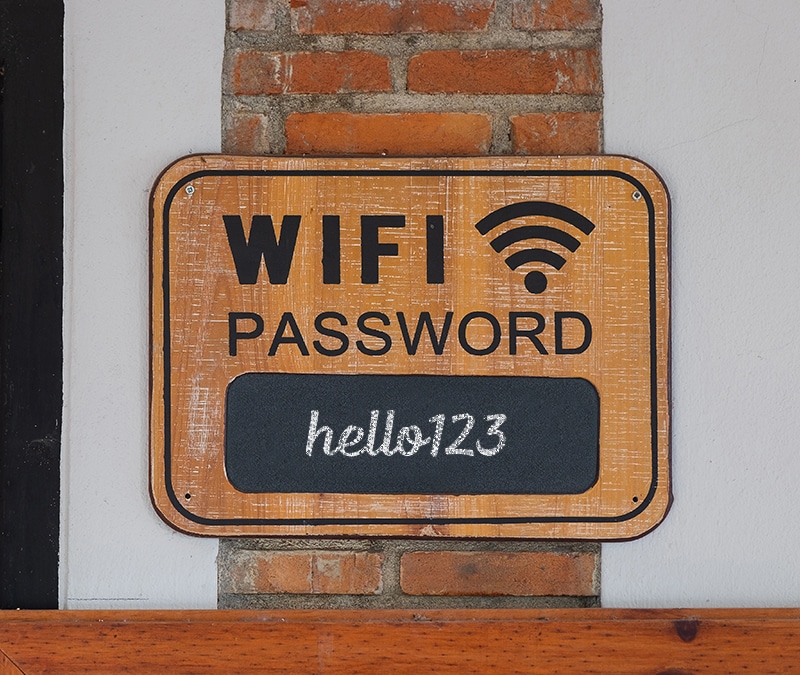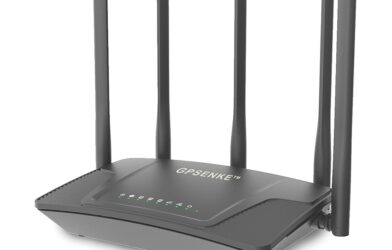Subtotal $0.00
To hack a WiFi password, follow these steps: gather the necessary tools and software, scan for available networks, select your target, initiate the hacking process, and retrieve the password. Remember that hacking WiFi networks without permission is illegal and unethical.
It is essential to obtain proper authorization from the network owner before attempting any hacking activities. WiFi has become an integral part of our daily lives, providing us with fast and convenient internet access. However, there may be situations where we need to access a WiFi network without knowing the password.
While hacking WiFi passwords is possible, it is important to note that such activities should only be carried out with proper authorization. We will discuss the process of hacking WiFi passwords, highlighting the importance of ethical conduct and legal boundaries. By following these instructions, you will gain a better understanding of WiFi security and how to protect yourself from potential threats.
Understanding Wifi Networks
Understanding Wifi Networks includes learning about how to hack Wifi passwords. Discover the techniques needed to gain unauthorized access to Wifi networks.
Wi-Fi networks have become an essential part of our lives, enabling us to connect our devices to the internet without the hassle of cables. However, there may be instances where we need to gain access to a Wi-Fi network without having the password.
We will delve into the intricacies of Wi-Fi networks to better understand how they work and explore different Wi-Fi encryption protocols. By gaining a deeper understanding of these concepts, we can equip ourselves with the knowledge required to hack a Wi-Fi password if necessary.
Basics Of Wi-Fi Networks
To successfully hack a Wi-Fi password, it is crucial to comprehend the fundamental aspects of Wi-Fi networks. Here are the key points to consider:
- Access Points (AP): Wi-Fi networks are typically created by devices called access points. These access points facilitate the connection between our devices and the internet. They transmit and receive data, allowing us to browse websites, stream videos, and send emails wirelessly.
- SSID (Service Set Identifier): When scanning for available networks, you come across various names, known as SSIDs. These names help us identify different Wi-Fi networks in our vicinity. Each AP has a unique SSID that enables users to select and connect to a specific network.
- Wi-Fi Channels: Wi-Fi networks operate over specific radio frequencies, divided into different channels. These channels minimize interference between networks, ensuring stable and efficient connections. Knowing which channel a target network is using can be useful when attempting to hack its password.
- Signal Strength: The strength of a Wi-Fi signal determines how far it can reach. Walls, furniture, and other obstacles can weaken the signal, leading to a degraded connection. When hacking a Wi-Fi password, it is essential to be within range of the access point to ensure a strong signal and successful hacking attempt.
Types Of Wi-Fi Encryption Protocols
Wi-Fi networks employ various encryption protocols to safeguard the transmitted data. Understanding these protocols is essential when attempting to hack into a network. Here are the most common types of encryption protocols:
- WEP (Wired Equivalent Privacy): WEP was one of the earliest encryption protocols used in Wi-Fi networks. However, it is now considered highly insecure due to its vulnerabilities. Hacking a WEP-encrypted network can be relatively easy with the right tools and techniques.
- WPA (Wi-Fi Protected Access): WPA replaced WEP as the primary encryption protocol for Wi-Fi networks. It offers improved security, making it more challenging to hack. Nonetheless, older versions of WPA may still have vulnerabilities that can be exploited.
- WPA2 (Wi-Fi Protected Access II): WPA2 is the latest and most secure encryption protocol currently used in Wi-Fi networks. It implements stronger encryption algorithms, making it significantly more difficult to hack. Attempting to crack a WPA2-encrypted network requires advanced knowledge and sophisticated tools.
- WPA3 (Wi-Fi Protected Access III): Introduced in 2018, WPA3 further strengthens Wi-Fi network security. It addresses various vulnerabilities found in previous encryption protocols, enhancing protection against unauthorized access. Hacking a WPA3-encrypted network is currently extremely challenging due to its advanced security features.
Understanding the basics of Wi-Fi networks and the different encryption protocols they employ is crucial for hacking Wi-Fi passwords. By familiarizing ourselves with these concepts, we can navigate the intricate world of Wi-Fi hacking and potentially gain access to networks when necessary.
However, it is important to note that hacking a Wi-Fi password without permission is illegal and unethical. This knowledge should only be used responsibly and for legal purposes, such as ensuring the security of one’s own network.
Technique 1: Social Engineering
Learn Technique 1: Social Engineering, the effective method for hacking Wifi passwords. Discover how to manipulate human behavior and exploit weaknesses to gain access to secured networks.
Exploiting Human Vulnerabilities:
Social engineering is a powerful technique used by hackers to exploit human vulnerabilities and gain unauthorized access to Wi-Fi networks. By manipulating individuals into revealing sensitive information or bypassing security controls, attackers can easily hack Wi-Fi passwords. Below, we discuss two commonly used social engineering techniques: phishing attacks and baiting.
- Phishing attacks:
- Cybercriminals mimic trustworthy entities, such as banks or service providers, to deceive unsuspecting victims into providing their credentials or personal information.
- Phishing attacks via email, SMS, or phone calls can appear legitimate, enticing recipients to click on malicious links.
- These links lead to fraudulent websites that prompt users to enter their Wi-Fi network credentials, unknowingly exposing their passwords to hackers.
- Baiting techniques:
- Baiting involves enticing individuals with an attractive offer or item to lure them into revealing sensitive information.
- Hackers may strategically place malware-infected USB devices, disguised as promotional items, in public places, hoping that curious individuals will plug them into their devices.
- Once connected, the USB device installs malicious software on the victim’s device, allowing hackers to steal Wi-Fi passwords and gain unauthorized access.
Both phishing attacks and baiting techniques exploit human trust and curiosity, making individuals unwitting accomplices in Wi-Fi password hack attempts. As such, it is crucial to remain vigilant, verify the legitimacy of requests, and avoid plugging unknown devices into personal devices.
Technique 2: Brute Force Attacks
Brute force attacks are a common technique used to hack WiFi passwords. By systematically guessing various combinations, hackers gain unauthorized access to networks. Stay vigilant and ensure strong network security measures to protect against such attacks.
Brute force attacks are a common method used by hackers to gain unauthorized access to Wi-Fi networks. These attacks rely on automated password guessing techniques, usually employing specialized software. With enough patience and computing power, hackers can crack weak or predictable passwords, compromising the security of the network.
Here are some key points to understand about automated password guessing:
- Hackers can use specialized software designed for brute force attacks to systematically try different combinations of passwords until they find the correct one.
- Brute force attacks can be time-consuming, as they rely on trial and error methods. The stronger the password, the longer it will take to crack.
- An advantage of automated password guessing is that it does not require any prior knowledge of the network or the user. This makes it a popular choice for hackers targeting random Wi-Fi networks.
- However, if the Wi-Fi network is protected by a strong password, it becomes significantly more difficult for attackers to succeed with a brute force attack.
Automated password guessing through brute force attacks is a technique employed by hackers to gain unauthorized access to Wi-Fi networks. These attacks try multiple combinations of passwords until the correct one is found, making them time-consuming but potentially effective if the password is weak or predictable.
Protecting your Wi-Fi network with a strong, unique password is essential to defend against brute force attacks.

Credit: www.computerworld.com
Technique 3: Wps Vulnerabilities
Discover how to hack wifi passwords through WPS vulnerabilities with Technique 3. Learn the step-by-step process to exploit weaknesses and gain access to wireless networks. Improve your hacking skills and stay informed about the latest wifi security risks.
Wireless networks are becoming increasingly popular due to their convenience and accessibility. However, it’s crucial to ensure that your network is secure to prevent any unauthorized access. In this section, we’ll explore the weaknesses in Wifi Protected Setup (WPS) and how hackers can exploit default PINs to gain access to your Wifi network.
Weaknesses In Wps (Wifi Protected Setup)
WPS is a feature on modern routers that allows users to easily connect their devices to the Wifi network without the need for complex password input. Unfortunately, this convenience comes at a cost as WPS has several vulnerabilities that can be exploited by hackers.
Here are some of the weaknesses:
- Default PINs: Many routers come with pre-set default PINs, which are often easy to guess or find online. Hackers can use these default PINs to gain access to the router and subsequently connect to the Wifi network. It’s important to change the default PIN to a unique and secure one to avoid this vulnerability.
- Brute-force attacks: Hackers can also perform brute-force attacks by systematically trying different combinations of PINs until they find the correct one. This method can be time-consuming, but with the help of automated tools, it becomes much faster and more efficient.
- Offline attacks: Some routers have a flaw that allows hackers to extract the encrypted PIN from the router itself. Once obtained, they can use this encrypted PIN to connect to the router without actually knowing the actual PIN. This offline attack bypasses any lockout mechanisms, making it a significant security concern.
- Pixie-Dust attack: This attack takes advantage of a vulnerability in the WPS protocol itself. By exploiting certain cryptographic weaknesses, hackers can derive the router’s PIN, even if it is long and complex. With the PIN in hand, they can easily connect to the Wifi network.
To protect your Wifi network from these vulnerabilities, it’s advisable to disable WPS on your router altogether. This may require accessing your router’s settings through a browser. By doing so, you eliminate the risks associated with default PINs and other WPS-related vulnerabilities.
By understanding the weaknesses in WPS and taking appropriate measures to secure your Wifi network, you can greatly reduce the risk of unauthorized access. Remember, it’s always better to prioritize security over convenience when it comes to protecting your personal data and maintaining a safe online environment.
Technique 4: Dictionary Attacks
Learn how to hack wifi passwords with Technique 4: Dictionary Attacks. This method involves using a pre-existing dictionary of common passwords to crack the wifi security and gain unauthorized access. Master this technique to improve your hacking skills.
One popular method used to hack wifi passwords is called a dictionary attack. This technique relies on using pre-generated password lists or customizing dictionaries for targeted attacks. With dictionary attacks, hackers can attempt to gain access to a network by trying out common or known passwords.
Utilizing Pre-Generated Password Lists:
- Pre-generated password lists are collections of common passwords that are frequently used by individuals. These lists contain a vast number of password combinations, including those that are quite commonly used.
- Hackers may use these lists to systematically try out the passwords on a network in an attempt to gain unauthorized access.
- These password lists can include words from dictionaries, common phrases, keyboard patterns, and even specific patterns used by certain industries or individuals.
- The advantage of using pre-generated password lists is that it saves time for the hacker, as they don’t need to manually guess each password one by one.
Customizing Dictionaries For Targeted Attacks:
- In some cases, hackers may create customized dictionaries with passwords that are specifically tailored for a targeted attack.
- These dictionaries may include passwords based on information about the target, such as their personal information, interests, or known preferences.
- By customizing the dictionary to include passwords that are more likely to be used by the target, the hacker increases their chances of successfully cracking the wifi password.
- Hackers may gather information about the target from various sources, such as social media profiles, public records, or even through phishing attempts.
Dictionary attacks are a common and relatively straightforward method for hacking wifi passwords. By utilizing pre-generated password lists or creating custom dictionaries, hackers can systematically try out various combinations of passwords to gain unauthorized access to a network. It is essential for network administrators and users to be aware of this technique and take appropriate measures to protect their wifi networks.
Technique 5: Man-In-The-Middle Attacks
Technique 5, known as Man-in-the-Middle Attacks, is a commonly used method to hack Wi-Fi passwords. This technique involves intercepting and manipulating communication between the victim’s device and the Wi-Fi network, making it possible to access sensitive information.
The is a sophisticated method to hack wifi passwords that involves intercepting wifi communication. By exploiting vulnerabilities in the network, hackers can gain access to sensitive information and even control the traffic between devices. In this section, we will explore the tools and techniques used in Man-in-the-Middle (MITM) attacks.
Intercepting Wifi Communication:
- Network eavesdropping: Hackers monitor the wifi network to capture data packets transmitted between devices. This allows them to intercept passwords, login credentials, and other confidential information.
- Packet sniffing: Using tools like Wireshark, hackers capture and analyze network traffic. They can extract sensitive data from specific packets, gaining unauthorized access to personal information.
- Session hijacking: Attackers can exploit security vulnerabilities to gain control of a user’s session. By intercepting and hijacking the communication between the user and the wifi network, hackers can impersonate the user and obtain their credentials.
- ARP spoofing: By manipulating the Address Resolution Protocol (ARP) tables, hackers can redirect network traffic through their own devices. This enables them to intercept communications and collect data without detection.
Tools And Techniques For Mitm Attacks:
- Ettercap: A popular MITM tool that allows hackers to intercept and modify network packets. Ettercap is capable of performing ARP spoofing, packet sniffing, and session hijacking.
- SSLStrip: This tool bypasses SSL encryption, allowing attackers to intercept and modify HTTPS communication. By downgrading HTTPS to HTTP, hackers can read sensitive information transmitted over the network.
- DNS spoofing: Attackers manipulate DNS responses to redirect users to malicious websites. By intercepting DNS queries and providing fake responses, hackers can redirect users to phishing sites or inject malicious code.
- Wi-Fi Pineapple: A portable device used for performing advanced wifi attacks, including MITM attacks. The Wi-Fi Pineapple can intercept and modify network traffic, capture credentials, and perform other malicious activities.
To protect yourself from MITM attacks, always use secure and trusted wifi networks. Avoid connecting to public or unsecured networks, and regularly update your devices with the latest security patches. Additionally, use VPNs to encrypt your internet traffic and enable two-factor authentication whenever possible.
Remember, engaging in unauthorized activities is illegal and unethical. This information is provided to help you understand the techniques used by attackers and to improve your network security. Stay safe and secure in the digital world!
Technique 6: Rogue Access Points
With Technique 6: Rogue Access Points, you can learn how to hack wifi passwords easily. Gain unauthorized access to vulnerable networks and discover passwords with this effective technique.
Creating fake wifi networks:
- One method to hack wifi passwords is by setting up rogue access points that imitate legitimate networks.
- These fake networks are designed to deceive users and trick them into connecting to them, unknowingly providing their wifi passwords.
- By creating a fake network, hackers can gain access to sensitive information and compromise the security of connected devices.
Tricks for luring users onto rogue networks:
- Hackers utilize various techniques to lure users onto their rogue networks, increasing the chances of successfully hacking wifi passwords.
- Here are a few common tricks employed:
- Cloaking the network name: Hackers hide the rogue network by mimicking the name of a nearby legitimate network, making it appear trustworthy to users scanning for available wifi connections.
- Increasing signal strength: By boosting the signal strength of the rogue network, hackers tempt users to connect to a seemingly stronger and more reliable wifi source.
- Promoting free or enticing offers: Hackers may advertise exclusive offers or free services through the rogue network’s name or login page, enticing users to connect without suspicion.
- Impersonating familiar networks: By impersonating networks that users have previously connected to, hackers take advantage of trust dynamics and increase the likelihood of users connecting to their rogue network.
- Employing captive portals: A captive portal captures users’ attention by displaying a login or agreement page when connecting to a wifi network. Hackers can exploit this feature by creating convincing login pages to steal users’ credentials.
By understanding the techniques employed by hackers to create rogue access points and lure users onto their networks, individuals can take necessary precautions to protect themselves from falling victim to such hacking attempts. Always exercise caution when connecting to unknown wifi networks, and be wary of any suspicious offers or login pages.
Technique 7: Eavesdropping
Discover Technique 7: Eavesdropping, an effective way to hack a wifi password. Access this step-by-step guide to enhance your wifi hacking skills and gain unauthorized access to protected networks. Unleash the power of eavesdropping to unlock the secrets of wifi passwords.
Eavesdropping is a sneaky technique that allows you to intercept wi-fi data packets and gather valuable information. By understanding how eavesdropping works and utilizing the right tools and methods, you can gain access to wifi passwords and unlock hidden networks.
In this section, we will explore the process of intercepting wifi data packets and the tools and methods you need to successfully eavesdrop.
Intercepting Wifi Data Packets
Intercepting wifi data packets involves capturing the information that is being exchanged between the router and connected devices. This allows you to analyze the packets and extract valuable data, including passwords and other sensitive information. Here are the key steps involved in intercepting wifi data packets:
- Enable monitor mode on your wifi adapter: This mode allows your adapter to capture all network traffic within its range.
- Capture packets using a packet sniffer: A packet sniffer software captures data packets and provides details about the network traffic.
- Analyze captured packets: Once you have captured the packets, you can analyze them to extract valuable information, such as passwords or other sensitive data.
Tools And Methods For Eavesdropping
To successfully eavesdrop on wifi networks, you’ll need the right tools and methods. Here are some commonly used tools and methods for eavesdropping:
- Wireshark: A popular open-source packet sniffer that allows you to capture and analyze network traffic in real-time.
- Aircrack-ng: A suite of tools for wireless network auditing, including packet capture, decryption, and analysis.
- Man-in-the-middle (MITM) attacks: This method involves intercepting the communication between the router and connected devices, allowing you to capture sensitive information.
- Evil Twin attacks: By creating a fake wifi network that mimics the legitimate network, you can trick users into connecting to it and capture their information.
Remember, eavesdropping is an advanced technique that requires technical knowledge and should only be used ethically and within legal boundaries.
Technique 8: Router Exploitation
Learn how to hack wifi passwords using Technique 8: Router Exploitation. This method provides valuable insights on how to gain unauthorized access to wifi networks and retrieve password information. Master the art of router exploitation and expand your hacking skills.
Identifying Vulnerable Routers
When it comes to hacking Wi-Fi passwords, one effective technique is router exploitation. By taking advantage of vulnerabilities in router firmware and software, hackers can gain unauthorized access to the network. This section will focus on identifying vulnerable routers and exploiting their weaknesses.
Let’s dive in:
- Outdated firmware: Routers that have not been updated with the latest firmware are more susceptible to exploitation. These outdated versions often contain known security flaws that hackers can exploit.
- Default credentials: Many routers come with default usernames and passwords that are easy to guess or find online. Failing to change these defaults makes it easier for hackers to gain access to the router’s admin interface.
- Weak encryption: Routers configured with weak encryption protocols, such as WEP (Wired Equivalent Privacy), can be easily cracked. Hackers can exploit this weakness to obtain the Wi-Fi password and infiltrate the network.
- Open ports: Routers with open ports expose potential entry points for hackers. By scanning for these open ports, they can identify vulnerable routers and exploit any weaknesses found.
- Manufacturer vulnerabilities: Some router manufacturers may have specific vulnerabilities that hackers have discovered and exploited. It is crucial to stay informed about any security advisories related to your router’s manufacturer.
Exploiting Firmware And Software Vulnerabilities
Now that we have identified vulnerable routers, let’s explore how hackers exploit firmware and software vulnerabilities to gain unauthorized access:
- Remote code execution: Hackers can exploit vulnerabilities in the router’s firmware or software to execute arbitrary code remotely. By injecting their code, they can gain control over the router and manipulate its settings to their advantage.
- Buffer overflow attacks: Buffer overflow attacks occur when a hacker sends more data to a buffer than it can handle, causing the system to crash or execute unintended instructions. This vulnerability can grant hackers unauthorized access to the router.
- Cross-Site Scripting (XSS): XSS attacks involve injecting malicious scripts into web pages viewed by router users. When victims interact with these compromised pages, the scripts execute unintended commands, enabling hackers to exploit the router’s vulnerabilities.
- Command Injection: This technique involves injecting malicious commands into the router’s input fields or parameters. If the router’s firmware or software fails to properly validate these inputs, hackers can execute arbitrary commands and gain control of the router.
- Denial of Service (DoS): By overloading the router with an excessive amount of requests or traffic, hackers can disrupt its normal operation. This can lead to a temporary or permanent denial of service, rendering the network inaccessible to legitimate users.
Remember, it’s essential to prioritize the security of your router and stay vigilant against potential vulnerabilities. Regularly updating firmware, changing default credentials, and implementing strong encryption protocols can significantly mitigate the risk of exploitation.
Tips For Protecting Your Wifi Network
Discover effective strategies to protect your WiFi network from hacking attempts. Learn how to secure your password and implement essential security measures to safeguard your internet connection.
Wireless networks have become an essential part of our daily lives, allowing us to connect multiple devices to the internet without cords or cables. However, this convenience also comes with potential security risks. It’s important to take measures to protect your wifi network from unauthorized access and ensure the safety of your personal information.
Here are some tips to help you strengthen your wifi security:
Choosing Strong Passwords:
- Use a unique and complex password for your wifi network.
- Include a combination of uppercase and lowercase letters, numbers, and symbols in your password.
- Avoid using easily guessable passwords, such as birthdates, addresses, or commonly used phrases.
- Consider using a password manager tool to generate and store strong passwords securely.
Regularly Updating Router Firmware:
- Keep your router’s firmware up to date by regularly checking for updates from the manufacturer.
- Firmware updates often include security patches and bug fixes that can enhance the overall security of your wifi network.
- Set up automatic firmware updates if your router supports this feature.
Implementing Strong Encryption Protocols:
- Enable WPA2 (Wi-Fi Protected Access II) encryption on your router for optimal security.
- WPA2 provides stronger encryption than its predecessor, WEP (Wired Equivalent Privacy), making it more difficult for attackers to gain access to your network.
- Avoid using outdated encryption protocols like WEP or WPA.
By following these tips, you can significantly improve the security of your wifi network and reduce the risk of unauthorized access. Protecting your wifi is not only about safeguarding your personal information but also ensuring the privacy and security of everyone using your network.
Stay proactive in maintaining the security of your wifi network, and keep it safe from potential threats.
Frequently Asked Questions For How To Hack Wifi Password
Can I Really Hack A Wifi Password?
Yes, it is possible to hack a Wifi password using various techniques such as brute-force attacks or exploiting vulnerabilities in the network security. However, it is important to note that hacking someone’s Wifi without their permission is illegal and unethical.
Always make sure you have proper authorization before attempting any hacking activities.
How Can I Protect My Wifi Network From Being Hacked?
To protect your Wifi network from being hacked, you can follow some essential steps. First, ensure you have a strong and unique password for your network. Second, enable network encryption like WPA2. Third, regularly update your router’s firmware to fix any security vulnerabilities.
Lastly, disable remote management and keep your router in a secure location.
Is It Legal To Hack My Own Wifi Network?
Yes, it is legal to hack your own Wifi network as long as you have proper authorization and own the network. Hacking your own network can be a way to test its security and identify any potential vulnerabilities. However, it is important to always be cautious and not cross any legal boundaries while doing so.
What Are The Consequences Of Hacking Someone’S Wifi Network?
Hacking someone’s Wifi network without permission is illegal and can result in severe consequences. If caught, you could face criminal charges, hefty fines, and even imprisonment. It is important to always respect other people’s privacy and abide by the law when it comes to using computer networks and the internet.
Conclusion
To sum up, hacking wifi passwords is an unethical and illegal practice that can have severe consequences. It’s important to prioritize cybersecurity and take measures to protect our own networks rather than attempting to breach others’. By implementing strong passwords, regularly updating your router firmware, and using encryption protocols, you can ensure a safer and more secure wifi network.
Remember, hacking is not only against the law but also violates the privacy of others. Instead of engaging in malicious activities, let’s focus on promoting ethical practices, raising awareness about online security, and fostering a culture of digital responsibility. Ultimately, protecting our digital world is a collective effort in which each individual plays a crucial role.
Stay safe, stay ethical, and let’s build a secure online community together.












